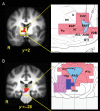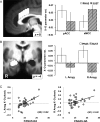Dissecting the anticipation of aversion reveals dissociable neural networks
- PMID: 22763169
- PMCID: PMC3698367
- DOI: 10.1093/cercor/bhs175
Dissecting the anticipation of aversion reveals dissociable neural networks
Abstract
The anticipation of future adversity confers adaptive benefits by engaging a suite of preparatory mechanisms, but this process can also be deleterious when carried out in excess. Neuroscientific investigations have largely treated anticipation as a unitary process, but we show here using functional magnetic resonance imaging that distinct stages of aversive anticipation are supported by dissociable neural mechanisms. Immediate anticipatory responses were observed in regions associated with threat detection and early processing of predictive cues, including the orbitofrontal cortex and pregenual anterior cingulate cortex, as well as the amygdala for individuals with elevated anxiety symptoms. Sustained anticipatory activity was observed in the forebrain/bed nucleus of the stria terminalis, anterior insula, anterior mid-cingulate cortex (aMCC), and midbrain/periaqueductal gray, regions associated with anxiety, interoception, and defensive behavior. The aMCC showed increased functional coupling with the midbrain during sustained anticipation of aversion, highlighting a circuit critical for the expression of preparatory fear responses. These data implicate distinct sets of regions that are active during different temporal stages of anticipation, and provide insight into how the human brain faces the future both adaptively and maladaptively.
Keywords: BNST; amygdala; anterior insula; fMRI; rostral cingulate.
Figures




References
-
- An X, Bandler R, Ongur D, Price JL. Prefrontal cortical projections to longitudinal columns in the midbrain periaqueductal gray in macaque monkeys. J Comp Neurol. 1998;401:455–479. - PubMed
-
- Bandler R, Keay KA, Floyd N, Price J. Central circuits mediating patterned autonomic activity during active vs. passive emotional coping. Brain Res Bull. 2000;53:95–104. - PubMed
-
- Barlow DH. Unraveling the mysteries of anxiety and its disorders from the perspective of emotion theory. Am Psychol. 2000;55:1247–1263. - PubMed
-
- Birbaumer N, Elbert T, Canavan AGM, Rockstroh B. Slow potentials of the cerebral cortex and behavior. Physiol Rev. 1990;70:1–41. - PubMed
Publication types
MeSH terms
Grants and funding
LinkOut - more resources
Full Text Sources

